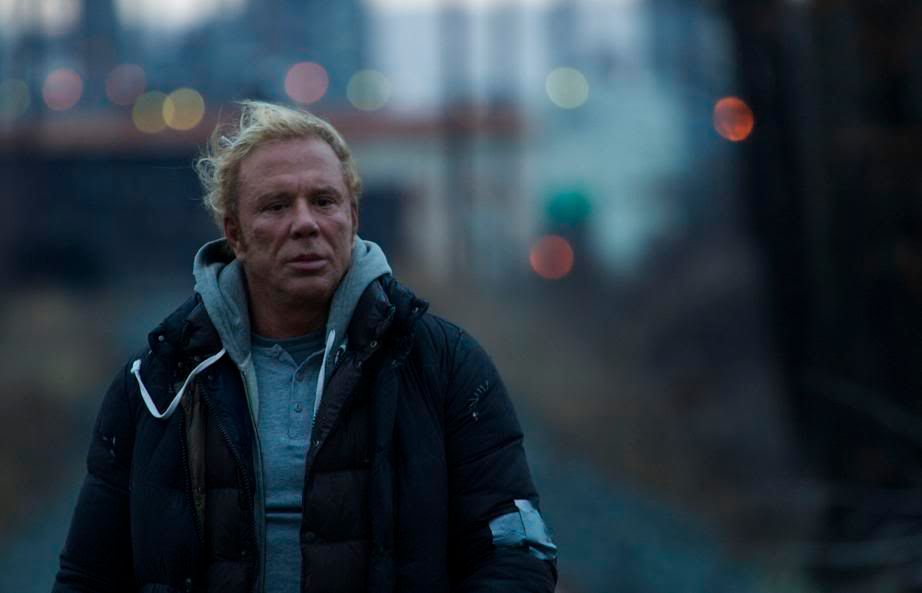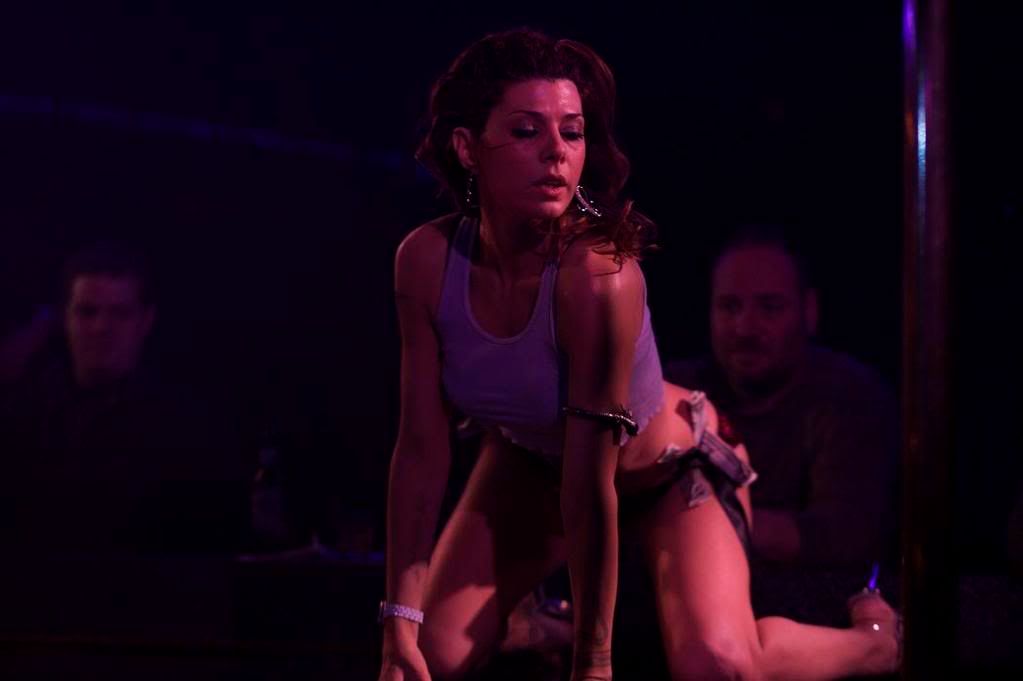
Darren Aronofsky's The Wrestler is a small, ragged character piece, modest in its ambitions but often striking in its emotional effects. It is not, as one would expect from the director of Requiem for a Dream, a particularly subtle movie, but in its broad gestures and shakycam aesthetics, it often locates a certain snub-nosed beauty at the fringes of the professional wrestling world. This is, among other things, a profoundly working class movie, about a guy named Randy the Ram (Mickey Rourke) who used to be a real tough guy, a contender, a famous pro wrestler with a line of action figures and posters reproducing his buffed image. Twenty years later, he's washed up, the rough life he's lived naturally catching up with him. He wears a hearing aid, presumably from getting his head bashed in too many times. His big, lumbering body is out of shape and he takes steroids to keep his muscles bulging, but the drugs are taking a toll on his weak heart. He once fought a high-profile bout in Madison Square Garden, but now he wrestles struggling up-and-comers in tiny rings with sparse audiences cheering him on; he's a has-been going down as he watches guys fighting to move up. Randy often can't pay his rent, and he takes whatever hours he can get hauling crates at a local supermarket. He hasn't seen his daughter (Evan Rachel Wood) in years, and his only sparks of real happiness come from his time in the ring and his flirtatious, affectionate encounters with the thirtyish stripper Cassidy (Marisa Tomei), herself starting to realize that she's over the hill in her business.
Aronofsky completely builds this film around Rourke, who is playing a version of himself in some ways: the guy who used to be on top of the world, and now everyone wonders what ever happened to him. His worn, lived-in face is the face of Randy the Ram, as is his looming, outrageous body, which would look like a padded suit of some kind if it wasn't so obviously real. It is a body that reveals the evidence of a hard life in every line, every bulge, every textured, lumpy surface. Rourke is Randy, and his mere presence lends the film a verité quality that would be impossible to replace. When the camera isn't running over the surfaces of Rourke's body, it's often right behind him, following him in the close, fluid way that's become a cinematic convention for tracking performers about to go out on stage. However, Aronofsky follows Randy in this way whether he's actually going out to wrestle, or just getting ready for work or going to the strip club. At one point, in one of those typically unsubtle touches of Aronofsky's, as Randy walks through the back rooms of the supermarket, his long blonde locks in a hairnet, heading out to the deli counter, the sound of a cheering, chanting crowd begins to build on the soundtrack, finally climaxing and cutting off just as the wrestler walks out into the deli area.
Despite these overblown touches, however, the film retains its nearly documentary quality, due largely to the phenomenally relaxed, natural performances of Rourke and Tomei, who never seem like anything more or less than exactly what they're supposed to be. There's an unstudied naturalness to the duo's scenes together. The parameters of their relationship are instantly apparent in the scene where Cassidy gives Randy a lapdance while chatting amiably with him: it's nominally just a transaction, a piece of business, but it's obvious that the two are relaxed and friendly together in a way they aren't with anyone else. Tomei is a revelation here. If Rourke acts mostly with his body, with his sculpted features and the tiny, nearly hidden eye-slits chiseled into his baroque face, Tomei projects her character's essence into her malleable face, into her subtle tics and expressions, the way she twists up her lips, the obvious awkwardness and lingering shyness in her eyes despite her hardened exterior. Yeah, she is, like most of the film's characters and plot elements, the embodiment of a cliché, the stripper with the heart of gold, but like Rourke she consistently mines the unseen depths beneath this familiar surface.

In fact, this might be described, more generally, as the film's method as well. Narratively, The Wrestler doesn't really have that much to offer, and it never pretends to. It is, unapologetically, a rather typical rise-and-fall story, a tragedy about an average guy who's been passed over by life, whose glory days are long past. He's the kind of past-his-prime guy Bruce Springsteen writes songs about; one reason why it was such a brilliant move to get the Boss to write Randy's closing credits eulogy, the film's moving title song. There's nothing especially surprising or unconventional here, and Aronofsky even has the gall to predict and subvert the inevitable complaints about the film's predictability and overt obviousness. For any clever critics who might have been tempted to make cracks about the film being The Passion of the Christ set in the WWE, Aronofsky basically includes the joke himself, giving the lines to Cassidy for a scene of jaw-dropping hammer-to-the-head allegory. This moment comes early, as though Aronofsky wanted to get it right out there in the open as quickly as possible: Randy is Jesus, with staple guns, barbed wire and glass standing in for the nails, thorns and scourges of Christ. It's a very funny moment, not least because Cassidy, intoning a portentous scriptural passage for Randy, quotes from the Mel Gibson film rather than directly from the Bible. This is religious symbolism by proxy, the rote religious references picked up wholesale from other movies rather than from any real spiritual content. It's as referential and meta as a Tarantino flick.
And yet at the same time, The Wrestler manages to delve into the genuine and the moving within its schlocky reference points and conventional Hollywood narrative. The dialogue just always feels so tossed-off, so heartfelt, whether Randy's chilling backstage with his fellow wrestlers or playing a game of Nintendo with one of the local kids, who spends the whole time talking about how outdated this system is and how cool the newest Call of Duty game is. Anyone who has ever spent any time with a video game-obsessed little kid — or been one themselves — will recognize this scene. The same goes, I'd imagine, for the scenes between the wrestlers, which have that same sense of documentary-like fly-on-the-wall spectatorship.
As for the actual wrestling, Aronofsky captures the rough physicality of the sport that everyone knows is "fake." Though the film makes it clear that, in one sense, the wrestlers are certainly faking it — they're all good friends who hug and shake hands before and after bouts, no matter what animosity they display in the ring — the fights themselves never feel fake. And in the scrappy, low-budget venues Randy is reduced to playing, at least, there's plenty of very real blood flowing, especially during a hard-to-watch sequence in which the Ram faces off against a masochistic amateur who wallows in grisly self-mutilation with staples. The closeup of Randy's back after this battle, his flesh pockmarked with shards of glass and metal, concretizes the Christ metaphor, grounds it in the suffering of the hero, except that Randy doesn't suffer for anybody's sins other than perhaps his own.
Within the strictures of its hackneyed form, The Wrestler is a probing character study anchored by its dazzling central performances. Aronofsky is sensitive to the quality of Rourke's performance, and to the kinds of things likely to surround and happen to a guy like this. The film is refreshingly attuned to ordinary life, to working class struggles and the overpowering sense of failure that comes with the realization that one's best years are over. The film's saving grace is its attentiveness to the rhythms of life, the lulls and routines through which Randy lumbers, grunting and hauling the weight of his past around with him.







0Awesome Comments!